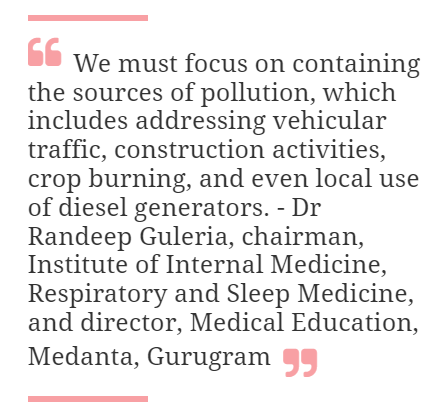Air pollution affects all of India’s 1.4 billion people

Air pollution affects all of India’s 1.4 billion people, according to a World Bank report of 2023. It is not just a silent killer, it also strangulates the economy. In 2019, India lost 3.6 per cent of its GDP to air pollution because workers fell sick, productivity was hampered and greater expenses on health care were incurred.
The AQI is a yardstick that runs from 0 to 500. At 301, it becomes hazardous.

The five major pollutants are ground-level ozone; particle pollution; carbon monoxide; sulphur dioxide and nitrogen dioxide. Particulate matter is a mixture of solid particles and liquid droplets found in the air. Some particles, such as dust, dirt, soot or smoke are large enough to be seen by the naked eye. When the measure of these particulate matters is 2.5 micrometres or less in diameter, they are invisible to the naked eye and can travel deep into the respiratory tract, getting to the lungs and causing short term problems such as coughing, sneezing and a runny nose, while long term health challenges include greater risk for asthma, heart diseases and low-birth weight. Hence the dreaded mentions of PM 2.5.
Dr Randeep Guleria, chairman, Institute of Internal Medicine, Respiratory and Sleep Medicine, and Director, Medical Education, Medanta, Gurugram, takes us through the issue. He says that in the west, it is held that chronic exposure to high levels of air pollution poses as significant a risk for heart disease as smoking or high cholesterol.
Two aspects of air pollution: The size of particles and whether they are water-soluble are to be considered. Gases like sulphur dioxide, nitrogen oxides and some other oxides are somewhat water-soluble, leading to irritation and airway narrowing, resulting in breathing difficulties, cough, nasal congestion, and occasional chest wheezing.
Additionally, there is particulate matter, particularly PM 2.5, comprising small particles that may carry toxic substances. Even smaller particles, referred to as ultra-fine particulate matter, penetrate deep into the lungs, causing inflammation. Continuous inhalation can allow these particles to enter the bloodstream, leading to inflammation in lung-associated vessels and systemic diseases, including cardiac and neurological conditions. Prolonged exposure increases the risk of chronic obstructive pulmonary disease (COPD), raises the likelihood of lower respiratory tract infections in high-risk groups, and, according to some data, may even elevate the risk of lung cancer over years.
Size matters: Particles larger than 10 microns are typically filtered out by our nasal passages and throat, and do not usually reach the lungs, so they are less concerning. However, PM 2.5 can enter the lungs and cause damage, including inflammation and swelling. This inflammation can exacerbate underlying lung conditions, causing symptoms like chest tightness and constriction. Even individuals without pre-existing lung issues can experience chest tightness, breathing difficulties and wheezing when pollution levels are high. This is because gases like sulphur dioxide, nitrogen dioxide, ozone and particulate matter can damage the lining of the airways and bronchial walls, leading to congestion and spasms, which can mimic asthma-like symptoms.
The reach of particulate matter: These fine particulate matter particles do not just impact the lungs; they can enter our bloodstream, causing systemic effects. This can increase the risk of heart diseases, worsen heart failure, lead to arrhythmias (irregular heartbeat). Emerging data suggesting a connection to stroke, dementia and other organ problems.

The extreme of lung scarring: This essentially indicates damage to the lungs, which tends to contribute more to COPD rather than actual scarring associated with interstitial lung disease (ILD- an umbrella term for a large group of diseases that cause lung scarring). In cases where the exposure decreases, especially in studies involving children and young people, there is evidence suggesting potential improvement in lung function. Studies on children indicate that as AQI improves, their lung function tends to show improvement. However, in older individuals with significant lung damage, particularly those with COPD caused by prolonged exposure to air pollution, the rate of scarring progression may slow down.
A hellish winter for north India: We need to consider a few key factors. First, we are situated in the Indo-Gangetic plain, which is a landlocked region. During the winter months, when there is minimal wind velocity, all the locally generated pollution settles in this area, making it difficult to disperse. To address this issue, we must focus on containing the sources of pollution, which includes addressing vehicular traffic, construction activities, crop burning, and even local use of diesel generators.
Being outdoors: Go outdoors when the sun is shining and ground-level pollutants have somewhat subsided. If you can engage in indoor exercises, either at a gym or at home, that would be a preferable alternative.
Impact on different populations: When considering long-term impacts, we are looking at effects on both the lungs and the entire system. In terms of the lungs, prolonged exposure to high pollution levels can lead to chronic bronchitis, increase the risk of lung cancer (comparable to high cholesterol or smoking) and elevate the likelihood of stroke. Studies also suggest a potential link between air pollution and conditions such as dementia and diabetes. For the elderly, constant exposure may result in breathing difficulties, coughing, a higher likelihood of hospitalisation and an increased chance of requiring ICU care, especially if oxygen saturation levels fall.
The question of exercise: I would advise against performing outdoor exercises in areas with high pollution levels. When you exercise, your respiratory rate increases, causing you to inhale more pollutants than usual. Activities like jogging and fast-paced walking should be avoided, especially for individuals at a high risk of chronic respiratory and heart diseases. If you choose to exercise, it’s safer to do so indoors or during times when the sun is out, and ground-level pollution is reduced. Breathing exercises, such as deep breathing, as well as upper and lower limb exercises to enhance cardiopulmonary capacity, are beneficial for improving lung health. Yoga and pranayama may offer some benefits in this regard as well.
Covid and irreversible lung damage: In some individuals, Covid has resulted in lung damage and lung fibrosis, but it typically is not extensive. Many people who exhibited lung changes on CT scans due to Covid have, over time, experienced significant recovery with minimal scarring. While concerns were initially raised about a potentially large number of cases with significant lung damage, most patients have ultimately healed and recuperated. So, post-Covid lung fibrosis does occur, but in terms of the overall number of Covid cases, it is not that widespread.
The self-healing capacity of the lungs: If exposure to pollution is reduced, it can to some extent slow the decline in lung health and stabilise it. This has been well-demonstrated in individuals whose lungs were damaged due to smoking. When lung capacity starts deteriorating rapidly from smoking and the individual quits smoking, it doesn’t return to normal, but the rate of decline in lung capacity decreases and stabilises. There may also be symptomatic improvement. If we extrapolate this to the effects of pollution, it is reasonable to assume that if exposure to pollution is reduced, the changes in the lungs may become less severe, leading to a reduction in the decline in lung capacity. However, some changes may persist and may not completely reverse.
The impact of co-morbidities: Co-morbidities that can greatly affect lung health include chronic lung diseases like COPD and asthma, as well as chronic heart disease. Having underlying chronic conditions such as diabetes predisposes individuals to a higher risk of deteriorating lung function and increased susceptibility to respiratory infections. Additionally, individuals at the extremes of age, such as the elderly and young children, are more vulnerable to the severe effects of pollution on lung health.
The effectiveness of air purifiers: Air purifiers have limited utility, primarily due to the persistently high levels of pollution. Furthermore, as most houses in India are not entirely airtight, outdoor air can still seep in even when windows and doors are closed. While air purifiers may offer some benefits, they are not a comprehensive, long-term solution to address the challenges posed by air pollution.
Masking up: Wearing a mask when going outdoors in areas with high levels of pollution can provide some degree of protection. While it may not be an ideal solution, something is better than nothing. As a daily practice, individuals can consider avoiding outdoor activities when pollution levels are very high. If they must go outside, wearing a mask can help reduce the particulate matter they inhale. It is also advisable to refrain from strenuous exercise in such conditions.
The uniqueness of respiratory ailments in India: The spectrum of respiratory ailments in India is diverse due to the country’s transition from primarily communicable diseases to an increasing burden of non-communicable diseases. While the burden of communicable diseases, such as tuberculosis of the lung, persists, there are specific factors unique to India. These include the use of cigarette smoke, biomass burning and indoor air pollution stemming from the combustion of fossil fuels, cow dung and other materials. These factors contribute significantly to respiratory problems, especially in rural areas where traditional cooking methods like the ‘chula’ are still prevalent. Moreover, the issue of outdoor and indoor air pollution also stands out, leading to a higher prevalence of lung diseases in the country.
Article Credit: theweek